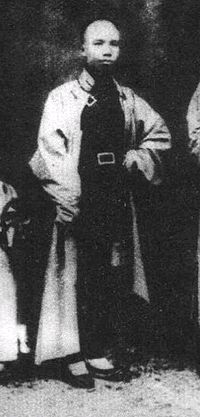Views
Tán Sìtóng 譚嗣同 (1865-1898)
|
| Notable Associates: |
|
Tán Sìtóng 譚嗣同 (1865-1898) was a reformer and intellectual of the late Qing, Tán was the author of Buddhist-inspired Rén xué 仁學.
Contents |
Biography
From Liúyáng County 瀏陽縣, Húnán 湖南. Tán was the son of an official and received a standard classical education growing up. He lived his early days in Běijīng 北京 and Gānsù 甘肅. When he was 12 he died for three days, then returned to life, which is why his courtesy name was "the Reborn."
It appears that like many literati of his time, he grew up with little knowledge or interest in foreign people or foreign ideas. This changed after he turned 24, when he followed his father to the city of Wǔchāng 武昌 where the latter was stationed as governor.
In 1893, Tán traveled to Shànghǎi 上海 where he met John Fryer 傅蘭雅, the head translator of the Jiāngnán Arsenal 江南機器製造總局. On that trip, Tán bought a number of the scientific and technical books published by the Arsenal. These books and the outcome of the First Sino-Japanese War had a tremendous impact on Tán, as he abandoned the classicism and ethnocentrism of his youth and began reading widely in Western learning. It was also during this period that he also became interested in Buddhism.
In 1896, Tán met Fryer again on a visit to Tiānjīn 天津. At that time, Fryer showed him fossils and an X-ray machine. That same year, Tán accepted an official position in Nánjīng 南京 and made the acquaintance of Yáng Wénhuì 楊文會, in whose house he lived and with whom he studied Buddhism. It was in that year, too, that he answered a request by a newspaper publisher in Hong Kong to write an introductory piece on Buddhism. The result of this effort, probably finished by February of 1897, was his Rénxué 仁學 (A Study of Humaneness).
Tán arrived in Běijīng on September 7, 1898 to participate in the Hundred Days' Reform. The reforms failed, and he was executed on September 28.
Major Works
Notes
- ↑ For an English translation, see T’an Ssu-t’ung. An Exposition of Benevolence: The Jen-hsueh of T’an Ssu-t’ung. Chan Sin-wai, trans. Hong Kong: Chinese University of Hong Kong, 1984.
References
- Chan, Sin-wai. Buddhism in Late Ch’ing Political Thought. Hong Kong: The Chinese University Press, 1985. Pp. 55-74.
- Shì Dōngchū 釋東初. Zhōngguó Fójiào jìndài shǐ 中國佛教近代史 (A History of Early Contemporary Chinese Buddhism), in Dōngchū lǎorén quánjí 東初老人全集 (Complete Collection of Old Man Dongchu), vols. 1-2. Taipei: Dongchu, 1974 Pp. 2.553-555.
- Yú Língbō 于凌波, ed. Xiàndài Fójiào rénwù cídiǎn 現代佛教人物辭典 (A Dictionary of Modern Buddhist Persons), 2 vols. Taipei: Foguang, 2004. Pp. 2:1726c-1729c.
